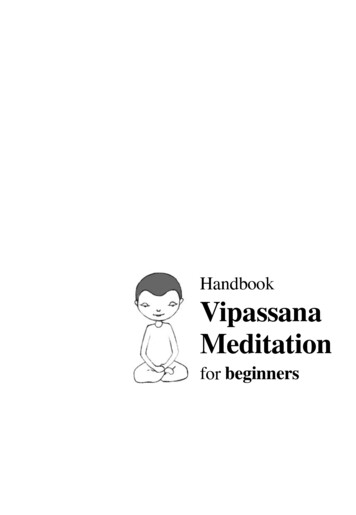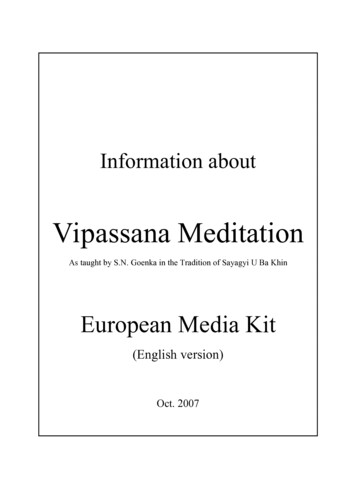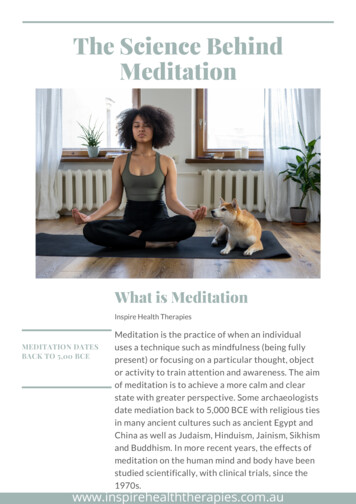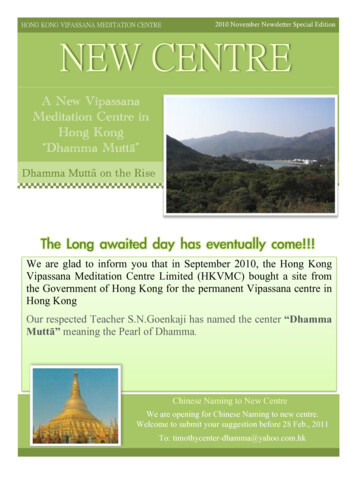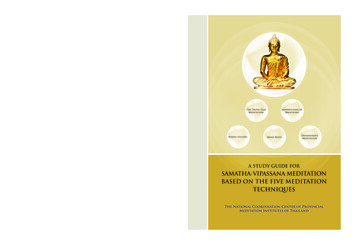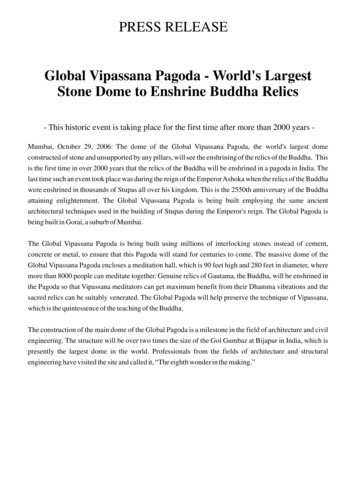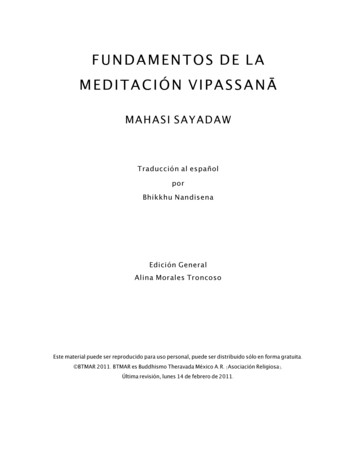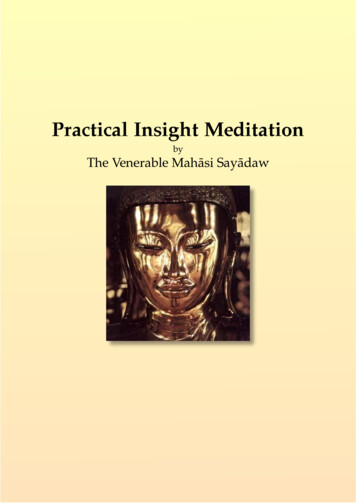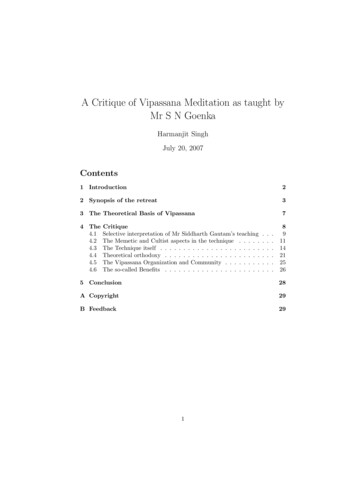
Transcription
A Critique of Vipassana Meditation as taught byMr S N GoenkaHarmanjit SinghJuly 20, 2007Contents1 Introduction22 Synopsis of the retreat33 The Theoretical Basis of Vipassana74 The4.14.24.34.44.54.6CritiqueSelective interpretation of Mr Siddharth Gautam’s teachingThe Memetic and Cultist aspects in the technique . . . . .The Technique itself . . . . . . . . . . . . . . . . . . . . . .Theoretical orthodoxy . . . . . . . . . . . . . . . . . . . . .The Vipassana Organization and Community . . . . . . . .The so-called Benefits . . . . . . . . . . . . . . . . . . . . .8911142125265 Conclusion28A Copyright29B Feedback291
This monograph is an attempt to critically analyze Vipassana (pronouncedas Vi-pashya-naa) as taught by Mr S N Goenka and his appointed teachers.Vipassana, like any other spiritual practice, has a worldview behind it. Theworldview, the philosophy as well as the technique itself are examined in thisarticle. I could not find any critical analysis of Vipassana on the internet andhence considered putting into this form my experiences and my thoughts aboutthis meditation practice. I hope this article can foster further discussion anddialogue amongst the Vipassana community and give a critical view to anyoneconsidering it for the first time. It may also be of some help to old meditators who are doubtful but cannot put their finger on what is wrong with thistechnique.1IntroductionMr S N Goenka and teachers trained by him, have been teaching a form ofVipassana meditation in India and abroad for the last 30 odd years. Vipassanais a Pali word meaning Special (Vi ) Observation (Passana). As taught byMr Goenka, the meditation technique is taught in 12-day retreats in specialcenters. The retreat involves observation of the breath and bodily sensationsover a twelve day period, after which the meditator is expected to continue themeditation in his daily life.Mr Goenka was born in Burma and learnt this technique from his teacher,Sayagyi U Ba Khin, whom he came across while seeking a cure for his troublesome migraine. Mr U Ba Khin was a disciple of Mr Saya Thet, who was in turna disciple of Mr Ledi Sayadaw. Mr Sayadaw was venerated as an Arahant (afully enlightened being) in his later years.Mr U Ba Khin established the International Meditation Center (IMC) inRangoon, two miles north of the famous Shwedagon pagoda. Today IMC hassix centers around the world. All the centres are guided by Mother Sayamagyi,Sayagyi U Ba Khin’s closest disciple, who has practised and taught meditationfor more than fifty years and have carried on the tradition since Sayagyi U BaKhin’s demise in 1971.1Mr Goenka spent fourteen years with Mr U Ba Khin and became a Vipassanateacher himself. It was U Ba Khin’s wish to go to India to teach and propagateVipassana in its country of origin but he could not fulfill his dream. Mr Goenka,was however, able to go to India and started teaching Vipassana. After manyyears, as the technique became popular, centers were established in variousparts of India and abroad. The headquarters of the Vipassana movement is inIgatpuri (near Bombay).The centers run retreats of varying durations, ranging from 12 days to morethan two months. The 12-day retreat is the most frequently held and attended.Since the primary vehicle for the meditation is this 12-day retreat, I will nowtry and give a precise synopsis of it.1 http://en.wikipedia.org/wiki/UBa Khin2
2Synopsis of the retreatThe retreats are fully residential and free of cost.They begin in the evening of the first day (Day Zero) and end on the morningof the 12th (Day Eleven).The retreats are referred to as 10-day retreats by the Vipassana organization,but since there are important activities on the day the students arrive and onthe day they leave, I will describe the retreat over the full twelve days. However,since in Vipassana literature, the days of the retreat are counted from the secondday (of the 12 day retreat), I will call the first day as Day Zero, the second dayas Day One, and so on.Each meditation center holding a retreat has a set of residences or dormitories for the students, two dining halls (one each for males and females), andone or more meditation halls. All instructions and discourses are provided viapre-recorded audio and video media in the voice of Mr Goenka in the meditationhall. In the hall, on a raised platform, there are one or more teachers who sit,meditate, operate the audio/video equipment and answer the students’ questions during break periods. The instructions and discourses are bi-lingual (inEnglish and in Hindi) (though special arrangements are made for people whodo not understand either of these languages) and the chanting is in Pali.The daily schedule is as follows:04000430 – 1100130014301530170018001900203021002130Wake up bellMeditation in the meditation hall (MH) or atone’s own residential quarters (RQ)Bath and BreakfastGroup meditation (GM) in MHMeditation in MH or at RQLunch and Rest, or meet with the teacherMeditation in MH or at RQGM in MHMeditation in MH or at RQTea breakGM in MHDiscourseMeditation in MHMeet with the teacherLights outAs one can see, the schedule is quite rigorous and people not used to wakingup early or sitting for long periods can find the first few days quite trying. Thethree group sittings (in bold above) are not optional and everybody has to staywithin the MH for the entire one hour. The other sittings are more flexible andone can either sit in the MH or at one’s own residence but one is expected tobe meditating during the designated periods. The breakfast is at 6.30am andlunch is at 11am. There is tea with some biscuits at 5pm for the new students(those who are undertaking the retreat for the first time). Old students are only3
allowed to have lemon water in the evening.Summary of the retreat8pm Day Zero: Retreat starts8pm Day Zero – 3pm Day Four: Anapana meditation (choiceless observation of the breath)3pm Day 4 – 9am Day 10: Vipassana meditation (equanimous observationof bodily sensations)9am Day 10 – 10am Day 10: Metta meditation (sharing one’s merit andgoodwill), silence ends4.30am Day 11 – 6.30am Day 11: Final discourse and Metta, Retreat endsDay ZeroThe students gather in the meditation center office and get registered. Theyacknowledge in writing that the course has a rigorous discipline and involveshard work. There is a light meal at 6pm. Preliminary guidelines about stayingin the center and about the course are given at 7pm. Students gather in frontof the meditation hall and are allotted seats (cushions) as they enter the hallone by one. At 8pm they undergo some formal vows and undertakings, whichare as follows:1. The Three Shelters: The students repeat, thrice, in Pali, that theyhereby get sheltered by the three gems (the Buddha (the Enlightened one),the Dhamma (the noble eightfold path) and the Sangha (the communityof seekers and monks)).2. The Five (or Eight) vows for the following ten days: New studentstake five vows:(a) To refrain from stealing(b) To refrain from killing(c) To refrain from telling lies (in this context, to remain in noble silence,i.e., to not communicate in any manner, verbal or non-verbal, withanyone except the administration or the teacher)(d) To refrain from sexual misconduct (in this context, to abstain fromall sexual activity including self-stimulation)(e) To avoid all intoxicantsOld students take three more vows:(f) To refrain from eating after noon(g) To refrain from any bodily decoration (ornaments etc.)(h) To refrain from sleeping on high or luxurious beds (however, all students, new or old, get similar accommodation and bedding)4
3. The Three Surrenders: The students surrender themselves for the nextten days to the teacher, the discipline and the teaching.4. The Request: The students formally make a request to be taught Anapana meditation.The students are then instructed to focus on the nasal region and to startobserving their breathing as it is naturally happening. At 9pm, all retire totheir individual rooms or dormitories.Day OneThe day proceeds as per schedule. The meditation during the first day involvesobserving the breath as it is naturally happening, as one inhales or exhales.The focus remains on the nasal region and on remaining aware of whether oneis using one or both the nostrils while breathing. The students are advised tobreathe a little hard for a few moments if they are unable to concentrate theirminds or if they are unable to feel the breath.Day TwoThe meditation during the second day involves observing the breath as before,with the added awareness of where the breath is touching the skin in the nasalregion.Day ThreeToday the awareness of breath includes what sensations one is feeling on theskin in the nasal region (on the nose, on the nostril rings and below the noseand above the upper lip).Day FourThe afternoon group sitting on day four is, unusually, from 2pm to 3pm. Till3pm the awareness of breath continues, with a further limitation of the area onwhich one is supposed to focus and experience the sensations. The new area offocus is limited to below the nostrils and above the upper lips.At 3pm, students make a formal request to be taught Vipassana and theteaching commences forthwith.The students are instructed to move their focus to the top of the head andmethodically move it through each part of the body till the focus reaches thetips of the toes, feeling the sensations on each part of the body as they traversethe body. The students are instructed not to either like or dislike the sensationsand to calmly and equanimously observe them as being transient phenomena.In the evening GM session, students are exhorted to remain still and notmove their hands, legs or to open their eyes during the entire one hour periodof the three GMs per day for the remainder of the retreat. These three sittings5
are now called Sittings of Strong Determination. This facet of the meditationis not mentioned in the course introduction brochure.Day FiveVipassana continues as taught on Day four.Day SixToday the traversal of focus through the body proceeds in both directions: fromthe head to the toes, and then from the toes to the head. Sensations are to beobserved equanimously with the understanding of their transience.Day SevenToday the traversal of focus through the body proceeds simultaneously andsymmetrically through both the arms, both the legs etc. and in both directionsas on day six.Day EightToday the traversal proceeds through as many parts as possible simultaneously(i.e. through the entire body, if possible, in one go). If the students can shiftthe focus easily through the body because of uniform subtle sensations in thevarious parts, they are instructed to let the focus flow and after one or two suchfree-flows, to again pass the attention through the body part-by-part.Day NineToday the traversal proceeds en masse through the body in a free flow if possible,and part-by-part otherwise. Those who can feel subtle sensations all over thebody are asked to see if they can feel the sensations inside the body as wellby moving their focus piercingly and penetratingly through the body. Thosewho can feel subtle sensations inside as well are asked to see if they can passtheir focus through the spinal cord as well. After this, the students who havebeen able to feel their bodies inside out are asked to do spot checks by takingtheir focus randomly to a body part and to see if the mind immediately feels asensation in the area of focus and if the sensation remains limited to the areaof focus.Day TenAfter the morning GM session, the students are taught Metta (or goodwill)meditation. In this, they are instructed to “fill” their subtle sensations withlove and compassion and to let the subtle sensations permeate the atmosphere.There are verbal suggestions to forgive and forget, to love all and to distribute6
one’s merits. After this session, at 10am, the noble silence ends and studentsinteract with each other but they cannot leave the center yet.The students can also buy books and audio/visual material on Vipassanaand donate as per their inclination.A film on Vipassana might be shown at 1pm in the MH. The afternoon andevening GMs happen as usual. The evening tea and snacks are open for the oldstudents as well. The discourse in the evening is not followed by meditation.Day ElevenIn the morning at 4.30am, students gather in the MH for a final video discoursewhich continues for two hours till 6.30am. This discourse advises the studentson how to continue the meditation practice at home and concludes with a finalsession of Metta, or goodwill.The students proceed for breakfast, clean up their residences, and leave asper their convenience in a few hours.3The Theoretical Basis of VipassanaThe technique is based on the following assumptions (enumerated by myself).Most of these assumptions can be traced to the various Indian religious orBuddhist traditions. Many of them are unique to Vipassana or to Buddhismand are not part of other religions or meditation practices:1. There is suffering and sorrow in life, and nothing but suffering and sorrowin life.2. The suffering is due to craving, aversion and ignorance.3. The conditioning which leads to craving and aversion is passed from birthto birth and can take many lives to get rid of, by assiduous practice ofVipassana.4. The freedom from suffering lies in a timeless, formless, non-sensory stateof bliss and not in the temporal, tangible and sensory realm.5. Craving and aversion for impermanent states and phenomena is a habitpattern of the mind.6. The mind can be divided into the superficial part and the deep part. Thesuperficial part is the intellect and the conscious mind, the deep part isthe unconscious mind.7. Changing the superficial mind and leaving the deep mind unchanged willnot lead to liberation from suffering.8. The deep mind functions at the level of, and reacts habitually to, bodilysensations whereas the superficial mind works logically and intellectually.7
9. Any sensory or relational experience in life, if interpreted as pleasant,leads to pleasant bodily sensations and vice versa, which are then reactedto with craving or aversion, respectively, by the deep mind.10. The superficial mind should be brought under a semblance of control bymoral strictures (called Sīla), it should be focused by a concentrationpractice (called Samādhi ), and the reactive habit patterns of the deepmind should be changed by then training the (superficial) mind to becomeaware of the bodily sensations and to not react to them but to understandthem as impermanent, full of suffering, and as egoless (this understandingis called Pragyā or Pañña). We should become masters of our minds.11. As the mind becomes unattached and equanimous towards sensory experiences, it can experience the non-sensory, timeless bliss which will lead tofreedom from the cycle of birth and death.12. This particular technique of practicing Vipassana was part of all religioustraditions but was lost and forgotten over the ages. It was formally rediscovered by Mr Siddharth Gautam (circa 500 BC) and was maintainedin its “pristine condition” by a few people in Burma.4The CritiqueThe critique is from several angles. A summary of the critique is as follows:1. Vipassana meditation as taught by Mr Goenka and his appointees is ahighly selective and subjective interpretation of Mr Siddharth Gautam’steaching.2. There are strong memetic and cultist aspects in the organization established by Mr Goenka and in the retreats held by it.3. There are very serious shortcomings with the technique itself. The technique can precipitate and exacerbate Depersonalization, a dissociative disorder (as defined in DSM-IV)4. There is a high degree of theory and orthodoxy in the description andrationalization of the technique.5. As in any institution promising evolution, people quickly organize themselves into a hierarchical and comparative setup and it is quite evident inVipassana.6. The benefits claimed to be the results of this technique need to be reexamined.8
4.1Selective interpretation of Mr Siddharth Gautam’steaching1. There is no proof of Mr Gautam having taught this technique in thisform (as claimed by Mr Goenka). Various Buddhist texts are cited andchanted in the retreat but nowhere in those texts is a methodical traversalof the body or focusing on the skin or patiently observing those partswhich cannot be felt (in the nasal region or in other parts of the body)recommended or described. If Mr Gautam had indeed re-discovered thistechnique which had been lost to humanity, it is reasonable to expect thathe would codify this technique or this practice quite descriptively in somediscourse or text.Mindfulness is one of the eight aspects of the Noble Eight-fold path inBuddhism. There are many kinds of meditation practices in Buddhism(see for example “Cultivating a Daily Meditation” by the Dalai Lama)but Vipassana, specifically, is a mindfulness practice.In the Mahasatipatthana Suttam (the Great Discourse on the Establishingof Mindfulness), Mr. Gautam mentions four aspects of a mindfulnesspractice. The discourse begins by describing the monk’s awareness of thenatural breath, and then proceeds to describing the following:Kayānupassanā: The awareness of the body and of bodily postures.Vedanānupassanā: The awareness of the sensations.Chittānupassanā: The awareness of the mind.Dhammānupassanā: The awareness of the mental contents and states.The Suttam is quite long. However, the section on Vedanānupassanā isvery short (only two paragraphs), only describing that a monk observessensations as follows:Here, O monks, a monk, while experiencing a pleasant sensation, knows properly, “I am experiencing a pleasant sensation”;while experiencing an unpleasant sensation, he knows properly,“I am experiencing an unpleasant sensation”; while experiencing a neither-pleasant-nor-unpleasant sensation, he knows properly, “I am experiencing a neither-pleasant-nor-unpleasant sensation.” While he is experiencing a pleasant sensation with attachment, he knows properly, “I am experiencing a pleasantsensation with attachment”; . . .Thus he abides observing sensations with sensations internally, or he abides observing sensations within sensations externally, or he abides observing sensations within sensationsboth internally and externally. Thus he abides observing thephenomenon of arising of sensations, thus he abides observing of passing away of sensations, thus he abides observing the9
phenomenon of simultaneous arising-and-passing-away of sensations. Awareness that, “This is sensation” remains present inhim. Thus he develops his awareness to such an extent thatthere is mere understanding along with mere awareness. In thisway he abides detached, without clinging or craving towardsanything in this world of mind and matter. This is how, monks,a monk abides observing sensations within sensations.2Nowhere is starting from the top of the head, traversing the body simultaneously and symmetrically etc., or stopping and focusing at the bodyparts which are not having subtle sensations, explicitly training the mindto remain detached to the sensations by mentally understanding theirtransience, etc. mentioned. In short, this technique of dispassionatelyobserving bodily sensations by a methodical traversal of the body as afull mindfulness practice is a development independent of Mr Gautam’steaching in this Suttam.2. Mr Goenka and the Vipassana Research Institute (VRI) give a specificmeaning to the word vedanā (sensation) used in Buddhist texts to suitthis technique of Vipassana in which one focuses on bodily (as in over andunder the skin) sensations to the exclusion of other sensory and mentalexperiences. Body sensations are due to various causes, including the foodeaten, the posture, body ailments, and the external environment. To this,VRI adds that the sensations can also arise from past conditionings of themind (sankhārās), which is dubitable at best and is not described by MrGautam anywhere in his discourses.In the chain of dependant origination in Buddhist philosophy, it is said:Dependant on the six sense spheres, contact arises.Dependant on contact, sensation arises.Dependant on sensation, craving arises.3Here sensation is clearly the sensation which follows a contact with anexternal sense object and can be any one of the various sensory experiences(i.e. sound, vision, taste, smell or touch, or mental processes) , and notjust the sensations on the skin or under the skin as claimed by Mr Goenkaand VRI.See, for example, the following words ascribed to the Buddha:“The six classes of feeling should be known.” Thus was it said.In reference to what was it said? Dependent on the eye andforms there arises consciousness at the eye. The meeting of thethree is contact. With contact as a requisite condition there2 Mahasatipatthana3 Vinaya,Suttam, published by VRI, April 1993, pp 21-23Mahavagga: VRI, 1; PTS 210
is feeling. Dependent on the ear and sounds there arises consciousness at the ear. The meeting of the three is contact. Withcontact as a requisite condition there is feeling. Dependent onthe nose and aromas there arises consciousness at the nose. Themeeting of the three is contact. With contact as a requisitecondition there is feeling. Dependent on the tongue and flavorsthere arises consciousness at the tongue. The meeting of thethree is contact. With contact as a requisite condition thereis feeling. Dependent on the body and tactile sensations therearises consciousness at the body. The meeting of the three iscontact. With contact as a requisite condition there is feeling.Dependent on the intellect and ideas there arises consciousnessat the intellect. The meeting of the three is contact. With contact as a requisite condition there is feeling. “The six classes offeeling should be known.” Thus was it said. . . 4And also, clearly, sankhārās are not a cause of sensation (they occur laterin the chain of origination). This will be dealt with in more detail later.4.2The Memetic and Cultist aspects in the techniqueMeme is a word coined by Richard Dawkins, an evolutionary biologist, which defines an idea or thought unit whose replication and propagation happen via themedia, the community, various institutions, rituals and practices (just as genespropagate via DNA). Organized religions and community practices cannot survive without a memetic propagation aspect and Vipassana is no exception. Notonly are memetic and cultist aspects quite visible in Vipassana, the organizationencourages these traits by various subtle and not-so-subtle means.One may reasonably wonder what compels Mr Goenka to propagate thistechnique and engage in such hard work to train the teachers and to teachthousands of people and maintain a donation-based series of centers. It mayindeed be possible that he is driven by a sense of compassion and altruism. Onemay be hard-pressed to find any selfish motives in a free-of-charge meditationretreat or (say) in a free meal in a Gurudwara or in a Church. But comprehension is made easier if one understands that propagation and acceptance of ideasone holds dear affords great inner pleasure and joy.To be sure, Vipassana has fewer cultist aspects than many other communities or new-age practices. But educated and otherwise intelligent people mayconclude that there are none, where there are in fact many.1. Use of Pali language is quite prevalent in Vipassana retreats. Pali is nota language in common usage anywhere in India at present but it is usedextensively in the Vipassana retreats. Right from the morning chants,to chants before or after each GM session, to chanting Bhavatu Sabbe4 ChachakkaSutta (Majjhima Nikaya 148)11
Mangalam (thrice) after every meditation sitting. Mr Goenka fondly usesthe Pali language because, in his own words, it has “good vibrations”.2. Use of Buddhist formalities and practices is explicit. Beginning with thesheltering under the triple gem, an important Buddhist ritual, to chantingin Pali for the vows and for requesting to be taught the meditation technique, and to all students chanting Sādhu Sādhu Sādhu after the BhavatuSabbe Mangalam, and use of the Buddhist terms of Sankhārā and Pragyā(or Pañña), these are all remnants of Buddhist traditions. As Buddhism isone of the minority religions in India, apart from the sense of novelty, thereviving of an obscure tradition can give a special and exclusivist pleasureto many people who suffer from rootlessness in the modern world.The espousal, in the retreats, of a non-material entity called Dhamma isa strong exhortation for people to propagate this meme. Even though itis mentioned many times in the retreat discourses that Dhamma meansnothing but the laws of nature and the nature of reality, in actuality,Dhamma has a very specific meaning from the Buddhist traditions andmeans the four noble truths and the noble eightfold path (see for examplethe section on Dhammanupassana (i.e. awareness of Dhamma) in theMahasatipatthana Suttam). It is disingenuous to give a special meaningto Dhamma in the discourses and then to chant on the ninth and thetenth day that “May Dhamma pervade every person and atom in theworld.” After all, if Dhamma is the law of nature, then it already pervadeseverything.3. Maintaining the purity and sanctity of the meme is of great importance toany memetic group. Mr Goenka lays formidable emphasis on the pristinemaintenance of the technique and practice. Teachers and old students arestrongly cautioned not to practice any other technique for fear of harm orof pollution to the technique, nor to change even the smallest aspect ofthe Vipassana practice. The teachers are trained to play the audio/videotapes of Mr Goenka as-is and are asked in no uncertain terms not toindulge in any discourse or to disseminate the technique on their own.In the Vipassana folklore, it has happened many times that a teacherhas been “blacklisted”, or a student has been barred from attending aretreat because of his/her practicing of Reiki or other vibe-oriented newage practices.4. Vipassana is subtly described as the one true path to liberation. All otherpractices and philosophies are described as either incomplete, as superficialintellectual games or as distant echoes of Vipassana. Due to the specialsignificance and rationale given to dispassionate observation of the bodilysensations, other techniques are considered as only being able to reformthe surface mind, whereas Vipassana is claimed to change the unconsciouslayers of the mind as well. Many teachers contemporary of Mr Goenkaare subtly put down, especially Mr Mohan Rajneesh, whose fleet of Rolls12
Royce’s and lack of emphasis on morality find an ironical and indirectmention in Mr Goenka’s discourses.5. Mr Goenka, the appointed teachers, and the old students are visibly attached to the technique and to its associated terms (Dhamma, Sankhārā,Mangal ) and phraseology. In the very words of Mr Goenka, after a yearor so of practicing, daily meditation becomes a necessity and one feelsuncomfortable at missing a daily sitting (a hallmark of addictive memes).Forming local communities of meditators and enrolling other family members is encouraged. The group dynamics are described as fostering “goodvibrations” and as “re-charging” of someone whose practice is not goingtoo well.6. Mr Goenka has a distinctive voice while chanting, which has a lot of reverberation (which sounds like gurgling) and low-frequency humming. Initially quite a few people are disconcerted by his voice since it is so unusual(he talks normally during the discourses) but memes are made strongerby distinction and one ascribes great qualities to things one finds strange.Repetition of various phrases and sentences (at the beginning and endof each meditation session) is made ritualistic despite the professed bestintentions of Mr Goenka.7. Creation of new symbols and communities is now proceeding with earnestin Vipassana circles. Naming of each meditation center in Pali and containing the word Dhamma, creation of a very large golden pagoda-cummeditation-center near Bombay (called the Global Pagoda) as a symbol ofthe resurgence of Vipassana and Buddhism in India, formation of specialresidential colonies near Igatpuri for Vipassana meditators who wish to livetogether, special newsletters and seminars containing announcements, poetry and testimonials, verificationist research papers (making no falsifiableclaims) etc., all are indicative of Vipassana establishing itself not just asa meditation technique, but also as an idea and as a community.8. The discourses play their own part in propagating the meme. The presentation of ideas in the evening discourses is very carefully planned (thediscourses have gone through various editions to refine their effectiveness).The discourses happen at the end of the day, when students have had ahard day, with their minds numb from focusing, and when they are lookingforward to rest. The final discourse happens at 4.30am on Day Eleven.Not only do the discourses happen at a time when students’ are tiredor not fully active, the content of the discourses makes them somethingto look forward to (they contain many jokes, anecdotes and stories) andthe ideas presented are easily imbibed by the students’ pliant minds. Thevarious subjects covered in the discourses are carefully chosen based on theday of the retreat to have the maximum effect. Various Indian religionsand deities are praised to give a comfort factor to the new students andto make them feel as if this is their own technique.13
It is not true that only the technique is explained in the discourses. Manyarcane Buddhist concepts and ideologies are described, including the repulsiveness of the body, the timeless, formless state of bliss, the four kindsof enlighten
Vipassana meditation in India and abroad for the last 30 odd years. Vipassana is a Pali word meaning Special (Vi) Observation (Passana). As taught by Mr Goenka, the meditation technique is taught in 12-day retreats in special centers. The retreat involves observation of the breath and bodily sensations
